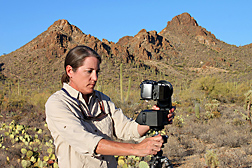This page has been archived and is being provided for reference purposes only. The page is no longer being updated, and therefore, links on the page may be invalid.
| Read the magazine story to find out more. |
|
|
|
|
Digital Panoramas of Rangelands Could Be Rich Source of Research Data
By Ann PerrySeptember 20, 2011
A scientist at the U.S. Department of Agriculture (USDA) is exploring how rangeland ecologists could use high-resolution digital panoramas to track landscape changes.
Agricultural Research Service (ARS) hydraulic engineer Mary Nichols uses a digital camera to create a single high-resolution landscape panorama that users can zoom in on to study individual plants, animals or specific features in the landscape.
Nichols works at the ARS Southwest Watershed Research Center in Tucson, Ariz. ARS is USDA's chief intramural scientific research agency, and this work supports the USDA commitment to enhancing sustainable agriculture.
To create these images, Nichols places a digital camera on a robotic camera mount and takes a series of pictures as the mount rotates. Then a custom computer program stitches the pictures together to create a panoramic image. In the end, hundreds-and sometimes thousands-of individual detailed photographs become part of a single high-resolution landscape panorama.
In October and November of 2008, Nichols created three rangeland panoramas in Arizona to see if scientists could use the images to monitor riparian areas, wildlife or invasive plants. The resulting panoramas were so detailed that she could count the number of elk in a distant herd, and even evaluate the condition of each animal.
Nichols could also identify stands of invasive buffelgrass, which turns golden yellow in the fall and presents a striking contrast to surrounding vegetation. With this information in hand, it was possible to document the extent of the buffelgrass invasion in the Santa Catalina Mountains. This provided a baseline assessment of the plant's establishment that could be used to track its subsequent spread.
Researchers can share their panoramas by posting them on www.gigapan.org. Nichols is collaborating with other researchers to develop a website specifically for high-resolution rangeland panoramas.
Results from this work were published in 2009 in Rangeland Ecology & Management.
Read more about this and other similar research in the September 2011 issue of Agricultural Research magazine.

